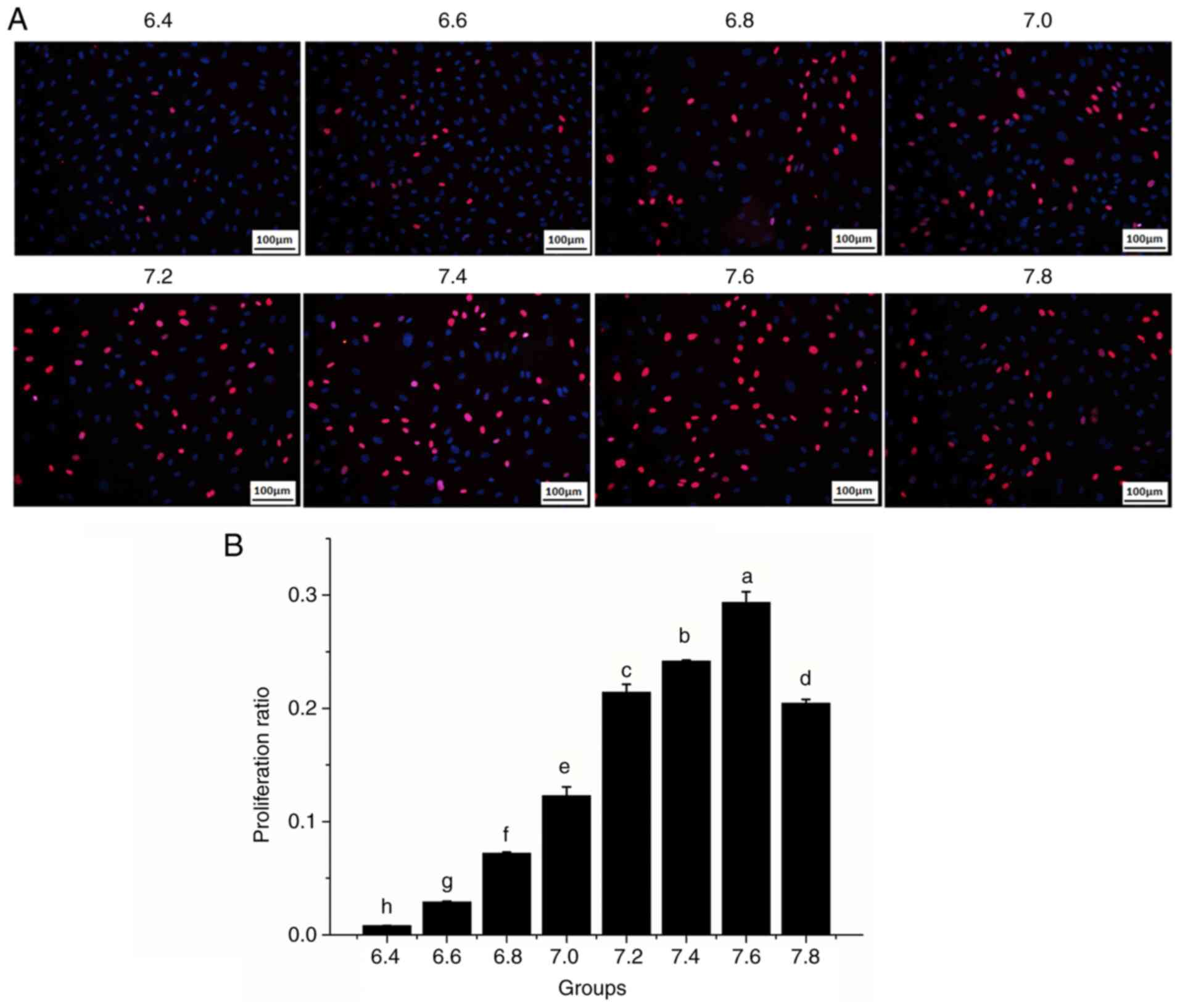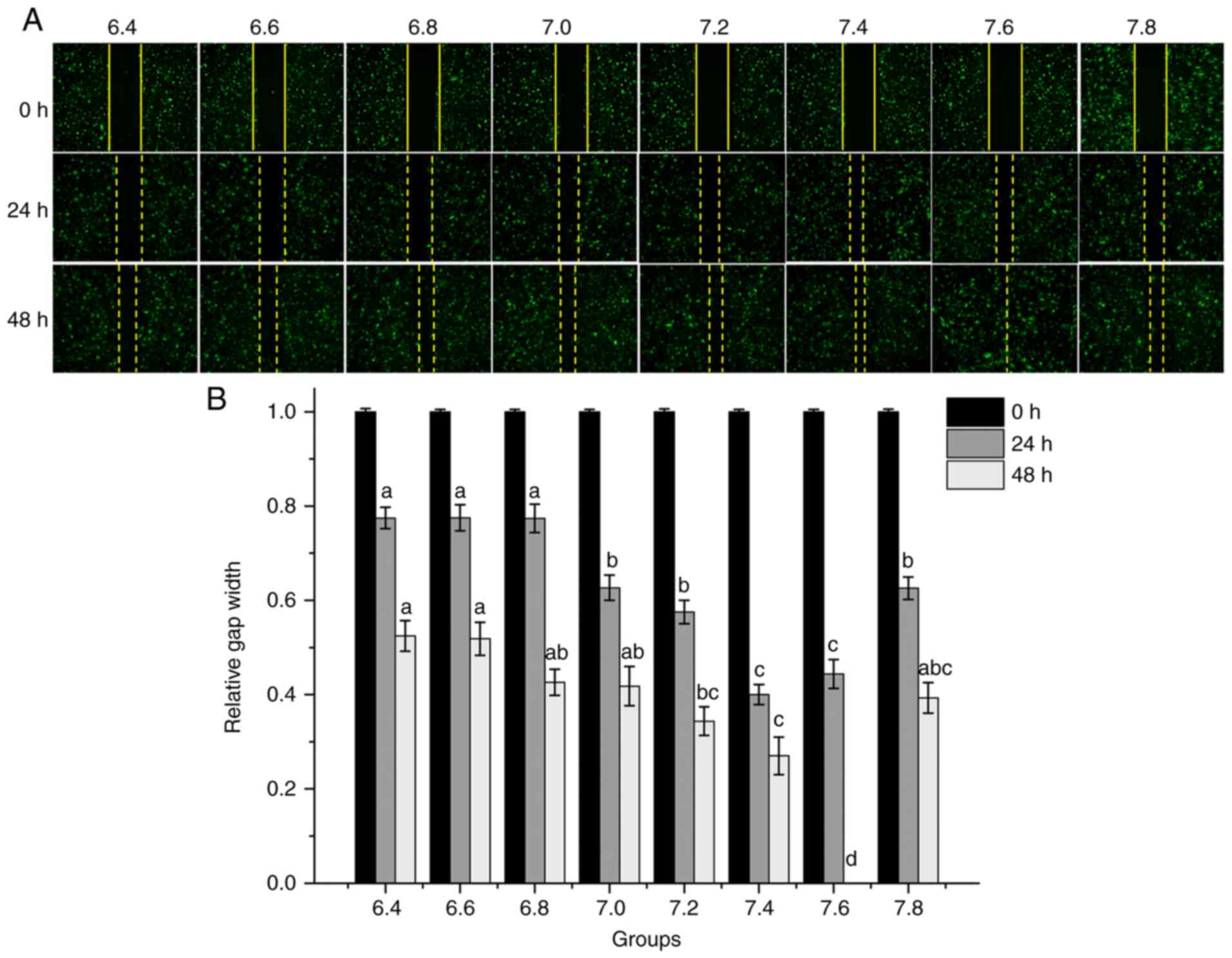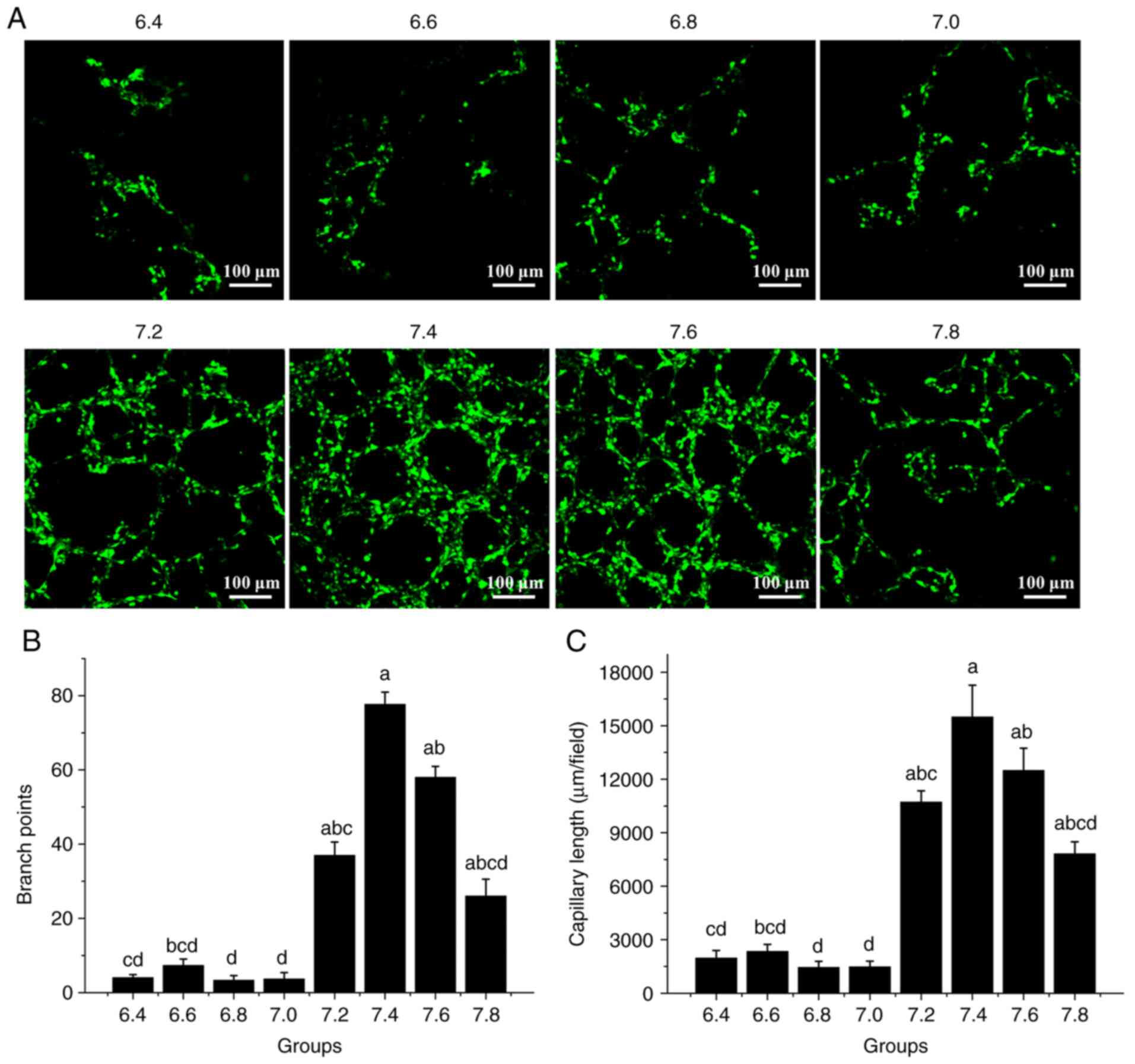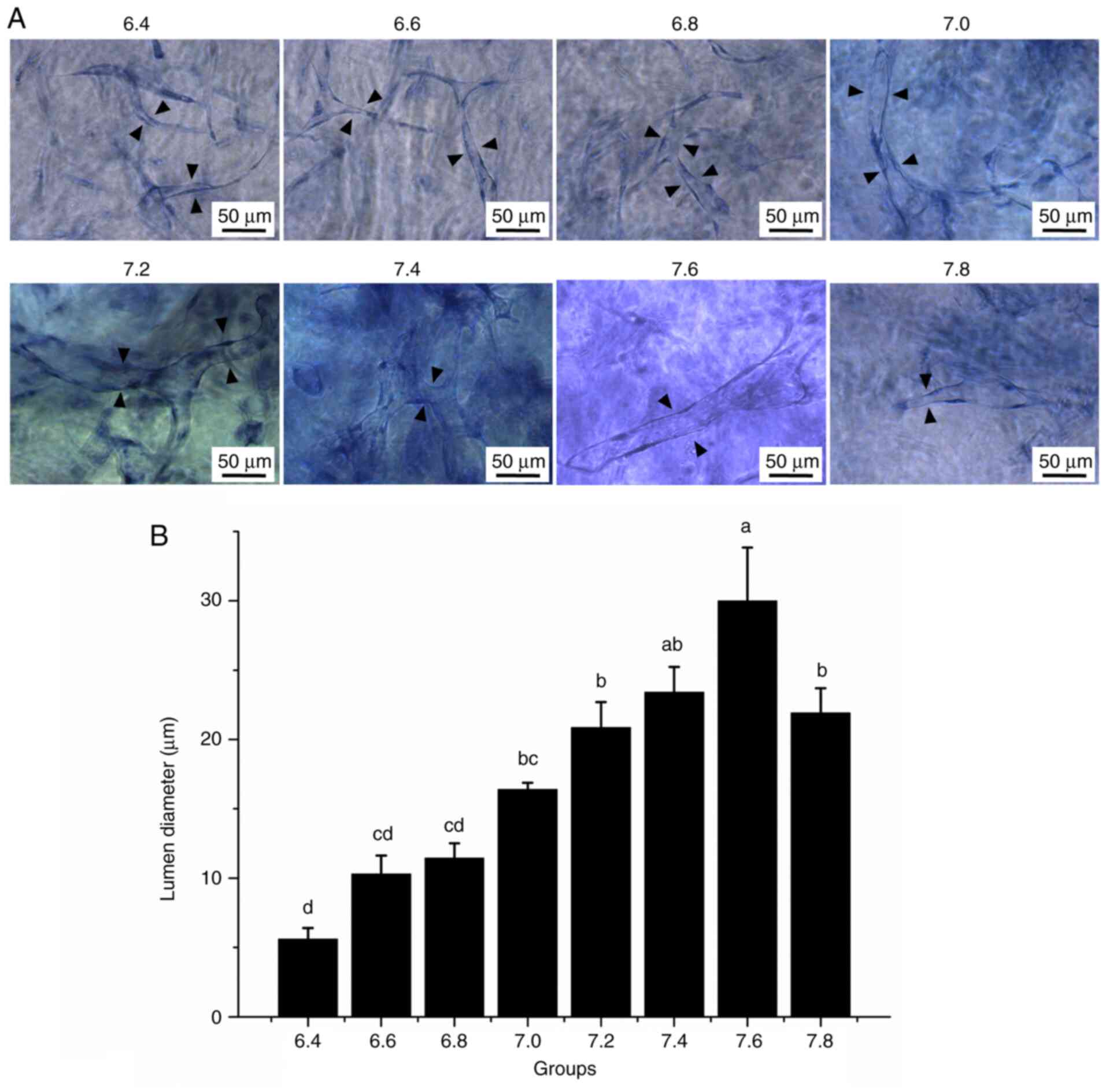pH regulates the lumen diameter of tissue‑engineered capillaries
- Authors:
- Published online on: February 15, 2022 https://doi.org/10.3892/etm.2022.11212
- Article Number: 284
-
Copyright: © Wang et al. This is an open access article distributed under the terms of Creative Commons Attribution License.
Abstract
Introduction
The lumen diameter directly affects the physiological function of capillaries and understanding its regulatory mechanism is important for the construction of functional tissue-engineered capillaries (1,2). If the diameter of the capillary lumen is too small, the passage of blood cells will be affected, causing damage to blood and vascular endothelial cells (3). When the lumen diameter is too large, it may result in an ineffective exchange of nutrients and metabolites between tissues and blood, leading to tissue hypoxia and accumulation of metabolites (4,5). However, the mechanisms underlying regulation of the capillary lumen diameter remain to be fully elucidated.
During wound healing, the pH of the surface layer of the granulation tissue is low (pH 5.8-6.0); the pH of the granulation tissue in the proliferative stage is 6.4-7.0 and the pH of the deep layer is close to that of the plasma (pH 7.3-7.6) (6,7). In tumor specimens, the capillaries near the center of the tumor tissue (pH 5.8-6.6) are relatively small in diameter or even without any definite lumen formation, while those near the edge of the tumor tissue (plasma pH 7.3-7.4) have larger lumen diameters (7,8). This suggests that the pH of the peripheral environment is one of the key factors that regulate the lumen diameter of newly formed capillaries.
However, pH, as a parameter for assessing the overall outcome, is not well studied, as the effect of the pH on the diameter of capillaries during neovascularization is rarely reported. Therefore, the present study aimed to explore the role of the pH in determining the vascular lumen diameter of new vessels.
Materials and methods
Cell culture
Human dermal microvascular endothelial cells (HDMECs; cat. no. 2000; ScienCell Research Laboratories, Inc.) were cultured according to the manufacturer's protocol in an endothelial cell medium (cat. no. 1001; ScienCell Research Laboratories, Inc.) supplemented with 5% fetal bovine serum (ScienCell Research Laboratories, Inc.), 100 U/ml penicillin-G, 100 U/ml streptomycin and 1% endothelial cell growth supplement (ScienCell Research Laboratories, Inc.). The cells were cultivated in 35-cm2 culture flasks at 37˚C under 5% CO2 in air. The culture medium was replaced every 24 h. The cells in passage 4 to 5 were used for experimentation. All experiments reported in this study were performed in triplicate.
Preparation of different pH media
Different concentrations of NaOH and hydroxyethyl piperazine ethanesulfonic acid were added into the endothelial cell medium and the pH of the medium was adjusted to 6.4, 6.6, 6.8, 7.0, 7.2, 7.4, 7.6 and 7.8 using a pH meter (model PB-10; Sartorius AG). A 0.22-µm membrane was used to filter the medium and remove bacteria, after which it was stored at 4˚C until use.
Cytosolic pH determined using flow cytometry
Cytosolic pH was assessed through flow cytometry using the pH-sensitive fluorescent probe 2,7-bis-(2-carboxyethyl)-5-(and-6)-carboxyfluorescein, acetoxymethyl ester (BCECF-AM; cat. no. ab143463; Abcam). The cells incubated in media with different pH for 12 h and were harvested by centrifugation and incubated in a culture medium containing 4 µM BCECF-AM in the dark at 37˚C for 30 min. The cells were washed with PBS and quantitative analysis of intracellular fluorescence was performed using a flow cytometer (BD FACSCalibur™; BD Biosciences). Data analysis was performed using the CELLQuest software tool (version 5.1; BD Biosciences).
Cell proliferation assay
The cells (5x105 cell/ml) were grown on polylysine-coated glass coverslips and stained with an anti-bromodeoxyuridine (BrdU) antibody (1:500 dilution; cat. no. B35128; Thermo Fisher Scientific, Inc.) at 4˚C overnight. The coverslips were washed with PBS and the cells were fixed with 4% paraformaldehyde for 15 min at 23˚C. The coverslips were placed in 2 mol/l HCl for 30 min and washed with PBS. The cells were incubated with goat anti-mouse Cy3-conjugated secondary antibodies (1:1,000; cat. no. ab97035; Abcam) at 37˚C for 2 h and then blocked with PBS containing 5% goat serum (cat. no. ab7481; Abcam) at room temperature for 1 h. Finally, the cells were stained with 4',6-diamidino-2-phenylindole for 10 min at room temperature and examined using a fluorescence microscope (Olympus IX 71 fluorescence microscope; Olympus Corporation).
Wound-healing assay
A wound-healing assay was used to evaluate the migratory behavior of HDMECs in media at varying pH. In brief, the cells were labeled with CellTracker™ (cat. no. C2925; Invitrogen; Thermo Fisher Scientific, Inc.) according to the manufacturer's protocol, and then confluent cells were scratched with a 200-µl micropipette tip to create a consistent wound gap in the middle. The cells were washed with PBS to remove any cell debris and media of varying pH without serum were added to allow wound healing. Images of the wound gap were acquired using a fluorescence microscope (Olympus IX 71; Olympus Corporation) at 0, 24 and 48 h at three random locations in each well to examine the distance of wound closure. Image-Pro Plus software (version 6.0; Media Cybernetics, Inc.) was used to calculate the migration rate.
Reverse transcription-quantitative PCR (RT-qPCR)
RT-qPCR was performed to detect the expression of endothelial angiogenesis-related genes [VEGFA, angiopoietin 1 (ANG1) and CD31] at different pH. Total RNA was extracted from the different groups of cells using a Takara MiniBEST Universal RNA Extraction kit (cat. no. 9767; Takara Bio, Inc.), according to the manufacturer's protocol. RT reactions were performed with PrimeScript™ RT Master Mix (cat. no. RR036A; Takara Bio, Inc.) according to the manufacturer's protocol. qPCR was performed using TB Green™ Premix Ex Taq ІІ (cat. no. RR820A; Takara Bio, Inc.) according to the manufacturer's protocol. The PCR amplifications were performed in Real Time Instrument (CFX Connect Real Time PCR system, Bio-Rad Laboratories, Inc.). Thermocycling conditions were: Initial denaturation at 95˚C for 2 min; 40 cycles of denaturation at 95˚C for 15 sec, annealing and elongation at 60˚C for 1 min; then a final extension at 72˚C for 3 min. The mRNA expression levels of the target genes were quantified using the 2-∆∆Cq (9) method and normalized to those of GAPDH. The primers used for qPCR are listed in Table SI.
Tube formation on Matrigel®
Endothelial cells rapidly attach, align and form capillary-like tubules on a reconstituted basement membrane matrix (10,11). Cold liquid Matrigel (cat. no. 354234; BD Biosciences) was added to 96-well plates at a volume of 50 µl/well and incubated at 37˚C in an incubator containing humidified air with 5% CO2 for 1 h. After the Matrigel had solidified, fluorescently-labeled (CellTracker™; cat. no. C2925; Invitrogen; Thermo Fisher Scientific, Inc.) HDMECs (2x104 cells/100 µl) were seeded into each well and incubated in the conditioned medium at 37˚C. Images were acquired after 24 h with a fluorescence microscope (Olympus IX 71; Olympus Corporation) to evaluate the degree of tube formation, which was quantified by measuring the branch length in three randomly selected fields using ImageJ software (version 1.51; National Institutes of Health).
Tube formation in a 3D Matrigel model
The cell suspensions with different pH values were mixed with Matrigel and cultured in 48-well plates under 5% CO2 at 37˚C. The cell tubes were stained using toluidine blue at room temperature for 10 min after 48 h cultured, as described previously (12). To observe tube formation, the cells were photographed under a microscope (Olympus IX 71; Olympus Corporation) after 3 days. The degree of tube formation was quantified by measuring the lumen diameter using ImageJ software (version 1.51; National Institutes of Health).
Statistical analysis
Values are expressed as the mean ± standard error of the mean of at least three independent experiments and all experiments were performed at least three independent repeats. Differences among groups were analyzed using one-way analysis of variance followed by Bonferroni correction for multiple comparisons. Statistical analysis was performed using SPSS 23.0 software (IBM Corporation). Figures were plotted using Origin 8.5 software (OriginLab Corporation).
Results
pH of the medium is tightly associated with the cytosolic pH
First, the effect of media with different pH on the cytosolic pH was determined (Fig. 1). An association between the relative fluorescence and the pH of the medium was observed; the cytosolic pH increased steadily with the increase in the pH of the medium. The specific data for each group are presented in Fig. S1.
pH affects the proliferation and migration of HDMECs
To investigate whether pH affects the biological properties of vascular endothelial cells, the effects of media of varying pH on cell proliferation and migration were examined. The cell proliferation rate increased as the pH increased to 6.4-7.6, particularly at pH 7.2-7.6; however, the cell proliferation rate decreased at pH 7.8 (Fig. 2A and B). The result of cell migration is analogous to proliferation. The cell images after 24 and 48 h revealed that HDMEC migration was significantly influenced by the pH (Fig. 3A and B). At pH values between 6.4 and 6.8, the migratory rate of HDMECs into the wound gap after 24 h of culture was relatively low (~22%) and only moderate wound coverage (~50%) was achieved after 48 h. By contrast, HDMEC migration into the wound gap was markedly enhanced by increasing the pH from 7.0 to 7.6; the ‘wound gap’ was completely covered at pH 7.6 after 48 h. However, compared with pH 7.6, the migratory rate of HDMECs decreased significantly at pH 7.8 (P<0.05).
pH influences the expression of angiogenesis-related genes
RT-qPCR analysis of the expression of angiogenesis-related genes further confirmed that the pH influenced their expression (Fig. 4). The expression of ANG1 gradually increased with the increase in pH and reached a maximum at pH 7.6 (Fig. 4B). Similarly, the expression of VEGFA was significantly higher at pH 7.0-7.8 compared with at pH 6.4-6.8; however, it decreased from pH 7.6 to 7.8 (Fig. 4A). By contrast, the expression of CD31 was only slightly altered with the increase in the medium pH and the differences between the groups were not significant (Fig. 4C).
Medium pH affects tube formation
An HDMEC tube formation assay was performed to evaluate the effect of the media at different pH on tube formation. The cells were seeded on Matrigel and the formation of tube-like cell arrangements was assessed. The tube formation capacity of the cells was evaluated by determining the branch points and branch length of the tubes (13,14). It was revealed that tube formation was significantly reduced at pH 6.4-7.0 compared with higher pH values (Fig. 5A). The histogram indicated that in comparison with those at pH 6.4-7.0, the number of branch points and the capillary length at pH 7.2, 7.4, 7.6 and 7.8 were significantly increased, the highest being at pH 7.4 and 7.6 (P<0.05; Fig. 5B and C). Therefore, the results indicated that 7.4 and 7.6 are the optimal pH values for HDMEC tube formation.
pH regulates lumen diameter in Matrigel
HDMECs formed tube-like structures in a 3D Matrigel model in media with different pH (Fig. 6). HDMECs formed tubules (Fig. 6A) and the diameter of the vascular tubules increased with an increase in the pH of the medium; however, at pH 7.8, the diameter of the vascular tubules was decreased. The histogram in Fig. 6B indicated that the lumen diameter increased steadily from pH 6.4-7.6, and significantly decreased at pH 7.8 (P<0.05). These results indicated that the pH of the medium has an important role in lumen formation.
Discussion
The regulation of capillary lumen diameter is important in the formation of tissue-engineered capillaries (15-17). The lumen diameter directly influences the physiological function of capillaries and its regulation is of great significance for the construction of tissue-engineered organs (18). Capillaries in normal tissues have diameters of 5-10 µm (19,20). If the capillary lumen diameter is too small, it will affect the passage of blood cells, resulting in blood cell and vascular endothelial cell damage (21). On the other hand, if the capillary lumen diameter is too large, the velocity of blood flow decreases, affecting the rate of delivery of oxygen, nutrients, growth factors and circulating cells necessary for the body (22,23).
In the present study, it was observed that the pH of the peripheral environment is a key factor in regulating the lumen diameter of newly formed capillaries. The extracellular pH affects the pH of the cytoplasm (24,25). Furthermore, the relationship between the pH of the medium and that of the cell cytoplasm was studied. In HDMEC cultures, an increase in the pH of the culture medium led to an increase in the pH of the cytoplasm. However, these corresponding changes were not always consistent. This may be attributed to the buffering capacity of HDMECs. Therefore, a change in the pH of the culture medium was able to affect the cytoplasmic pH of HDMECs, leading to a change in vascular diameter.
In in vivo vascular systems, capillaries that are between 5 and 10 µm in diameter are the only regions where nutrients and metabolites are able to be exchanged with tissues (19). The lumen diameter of capillaries from HDMECs formed in Matrigel was ~10 µm when the pH of the medium was 6.4-6.8. This size is suitable for forming capillaries in tissue engineering. This possibly suggests that smaller capillaries may be constructed using a medium with lower pH. A higher cytosolic pH is associated with increased cell growth and proliferation in mammalian cells (26), which is consistent with the results of the present study. Cell proliferation tests indicated that the proliferation ratio increased with an increase in the medium pH from 6.4 to 7.6, particularly at pH 7.2-7.6, but it gradually decreased at pH 7.8. The expression of ANG1 and VEGFA exhibited a similar trend. These results reflect the difficulty in constructing capillaries with small diameters; however, they further confirmed that a medium pH of 7.2-7.6 is optimal for in vitro neovascularization with HDMECs. The expression of CD31 remained unaffected. Therefore, the pH possibly does not affect cell adhesion. Both the capillary length and branch points of the tubes were associated with an increased cytosolic pH. This is particularly important for the construction of capillaries in tissue-engineered organs. Furthermore, in a previous study by Ye (27), wherein the acceptance rate of skin grafts in patients with acute and chronic wounds of different origin was observed, 99% of the skin grafts were successfully taken in wounds at a pH of 7.4 and higher; however, no skin graft was successfully taken in wounds at a pH <7.0. In combination with the results of the present study, this may be due to the presence of appropriate growth conditions for capillaries at pH 7.4 and 7.6, which provide sufficient blood supply, leading to improved wound healing.
Considering the results of cell proliferation, migration and tube formation, it was determined that the most optimal pH of the medium was 7.2-7.6 for in vitro neovascularization with HDMECs. This may be attributed to the closeness to the physiological pH of blood and extracellular fluids, which is in the range of 7.35-7.45 (28-30). At this appropriate pH range, the various enzymes had maximum activity, enabling improved formation of new blood vessels.
In conclusion, the present study observed that the pH regulated the diameter of the capillary lumen in HDMECs; the optimal pH was 7.4-7.6. However, the mechanisms underlying the regulation of the lumen diameter of capillaries by the pH remain to be fully elucidated. This will be our next research direction.
Supplementary Material
BCECF-AM in each group was examined using flow cytometry. The different pH ranged from 6.4 to 7.8 (displayed above each histogram). The abscissa represents the green channel; the ordinate represents the emission wavelength, which is positively correlated with the fluorescence intensity. BCECF-AM, 2,7-bis-(2-carboxyethyl)-5-(and-6)- carboxyfluorescein, acetoxymethyl ester.
Sequences of RNA primers (human species).
Acknowledgements
The authors would like to thank Professor Xiwang Hu (Experimental Center of the Third Affiliated Hospital of the Air Force Medical University) for his assistance with laser confocal microscopy.
Funding
Funding: This work was supported by grants from the National Natural Science Foundation of China (grant nos. 31570986 and 81701909).
Availability of data and materials
The datasets used and/or analyzed during the current study are available from the corresponding author on reasonable request.
Authors' contributions
XW, JinqL and XL designed the study. XW and JingL wrote the manuscript. XW, YB and CZ performed the experiments and JingL analyzed the data. All authors read and approved the final manuscript and confirm the authenticity of the raw data.
Ethics approval and consent to participate
Not applicable.
Patient consent for publication
Not applicable.
Competing interests
The authors declare that they have no competing interests.
References
|
Wang Z, Mithieux SM and Weiss AS: Fabrication techniques for vascular and vascularized tissue Engineering. Adv Healthc Mater. 8(e1900742)2019.PubMed/NCBI View Article : Google Scholar | |
|
Hati S, Agrawal S and Rai V: Vascular regeneration and tissue engineering: Progress, clinical impact, and future challenges. Regenerated Organs 153-166, 2021. | |
|
Munisso MC and Yamaoka T: Circulating endothelial progenitor cells in small-diameter artificial blood vessel. J Artif Organs. 23:6–13. 2020.PubMed/NCBI View Article : Google Scholar | |
|
Hamilton NB, Attwell D and Hall CN: Pericyte-mediated regulation of capillary diameter: A component of neurovascular coupling in health and disease. Front Neuroenergetics. 2(5)2010.PubMed/NCBI View Article : Google Scholar | |
|
Brewster L, Brey EM and Greisler HP: Blood Vessels. Principles of Tissue Engineering. 5th edition. Academic Press, Boston, 2020. | |
|
Schneider LA, Korber A, Grabbe S and Dissemond J: Influence of pH on wound-healing: A new perspective for wound-therapy? Arch Dermatol Res. 298:413–420. 2007.PubMed/NCBI View Article : Google Scholar | |
|
Barar J and Omidi Y: Dysregulated pH in tumor microenvironment checkmates cancer therapy. Bioimpacts. 3:149–162. 2013.PubMed/NCBI View Article : Google Scholar | |
|
Gerweck LE and Seetharaman K: Cellular pH Gradient in tumor versus normal tissue: Potential exploitation for the treatment of cancer. Cancer Res. 56:1194–1198. 1996.PubMed/NCBI | |
|
Livak KJ and Schmittgen TD: Analysis of relative gene expression data using real-time quantitative PCR and the 2(-Delta Delta C(T)) method. Methods. 25:402–408. 2001.PubMed/NCBI View Article : Google Scholar | |
|
Arnaoutova I, George J, Kleinman HK and Benton G: The endothelial cell tube formation assay on basement membrane turns 20: State of the science and the art. Angiogenesis. 12:267–274. 2009.PubMed/NCBI View Article : Google Scholar | |
|
Arnaoutova I and Kleinman HK: In vitro angiogenesis: Endothelial cell tube formation on gelled basement membrane extract. Nat Protoc. 5:628–635. 2010.PubMed/NCBI View Article : Google Scholar | |
|
Koh W, Stratman AN, Sacharidou A and Davis GE: In vitro three dimensional collagen matrix models of endothelial lumen formation during vasculogenesis and angiogenesis. Methods Enzymol. 443:83–101. 2008.PubMed/NCBI View Article : Google Scholar | |
|
Baker CD, Ryan SL, Ingram DA, et al: Endothelial colony-forming cells from preterm infants are increased and more susceptible to hyperoxia. Am J Respir Crit Care Med. 180:454–461. 2009.PubMed/NCBI View Article : Google Scholar | |
|
Hou HH, Hammock BD, Su KH, et al: N-terminal domain of soluble epoxide hydrolase negatively regulates the VEGF-mediated activation of endothelial nitric oxide synthase. Cardiovasc Res. 93:120–129. 2012.PubMed/NCBI View Article : Google Scholar | |
|
Nemeno-Guanzon JG, Lee S, Berg JR, Jo YH, Yeo JE, Nam BM, Koh YG and Lee JI: Trends in tissue Engineering for blood vessels. J Biomed Biotechnol. 2012(956345)2012.PubMed/NCBI View Article : Google Scholar | |
|
Catto V, Farè S, Freddi G and Tanzi MC: Vascular tissue engineering: Recent advances in small diameter blood vessel regeneration. ISRN Vasc Med. 2014(27)2014. | |
|
Ncube S, Akankwasa NT, Sibanda P and Ndlovu LN: Nanofibres for blood vessel tissue engineering: A review. MSAIJ. 12:218–225. 2015.PubMed/NCBI View Article : Google Scholar | |
|
Ziegler T and Nerem RM: Tissue engineering a blood vessel: Regulation of vascular biology by mechanical stresses. J Cell Biochem. 56:204–209. 1994.PubMed/NCBI View Article : Google Scholar | |
|
Davey B, Halliday T and Hirst M: Human Biology and Health: An Evolutionary Approach (Health and Disease). Open University Press, Philadelphia, PH, 2001. | |
|
Tilton RG, Hoffmann PL, Kilo C and Williamson JR: Pericyte degeneration and basement membrane thickening in skeletal muscle capillaries of human diabetics. Diabetes. 30:326–334. 1981.PubMed/NCBI View Article : Google Scholar | |
|
Tresoldi C, Pellegata AF and Mantero S: Cells and stimuli in small-caliber blood vessel tissue engineering. Regen Med. 10:505–527. 2015.PubMed/NCBI View Article : Google Scholar | |
|
Iruela-Arispe ML and Davis GE: Cellular and molecular mechanisms of vascular lumen formation. Dev Cell. 16:222–231. 2009.PubMed/NCBI View Article : Google Scholar | |
|
Schulz E and Münzel T: Lumen size matters: Role of protein disulfide Isomerase A1 in vascular remodeling. Hypertension. 67:488–489. 2016.PubMed/NCBI View Article : Google Scholar | |
|
Smith GA, Howell GJ, Phillips C, Muench SP, Ponnambalam S and Harrison MA: Extracellular and Luminal pH Regulation by Vacuolar H+-ATPase isoform expression and targeting to the plasma membrane and endosomes. J Biol Chem. 291:8500–8515. 2016.PubMed/NCBI View Article : Google Scholar | |
|
Zhao L, Cui L, Jiang X, Zhang J, Zhu M, Jia J, Zhang Q, Zhang J, Zhang D and Huang Y: Extracellular pH regulates autophagy via the AMPK-ULK1 pathway in rat cardiomyocytes. FEBS Lett. 590:3202–3212. 2016.PubMed/NCBI View Article : Google Scholar | |
|
Dechant R, Saad S, Ibáñez AJ and Peter M: Cytosolic pH regulates cell growth through distinct GTPases, Arf1 and Gtr1, to promote Ras/PKA and TORC1 activity. Mol Cell. 55:409–421. 2014.PubMed/NCBI View Article : Google Scholar | |
|
Ye RC: The relationship of pH of the granulation tissue and the take of the skin graft. Plast Reconstr Surg (1946). 19:213–217. 1957.PubMed/NCBI View Article : Google Scholar | |
|
Findlay M and Isles C: Disorders of Acid Base Balance. In: Clinical Companion in Nephrology. Springer International Publishing, Switzerland, 2015. | |
|
Cheng HM and Jusof F: Acid-Base Balance. Springer, Singapore, pp177-185, 2018. | |
|
Chaves MH, Wolf AR, Nascimento KA, Nawcki D, Feustel GM, Bettega PV, Ignacio SA, Brancher JA, Tannous LA, Werneck RI, et al: Sialochemical analysis in polytraumatized patients in intensive care units. PLoS One. 14(e0222974)2019.PubMed/NCBI View Article : Google Scholar |















